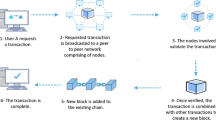Abstract
Blockchain is a promising technology that may act as a distributed ledger for Internet of Things (IoT). To maintain blockchain and save operation cost, IoT nodes may play roles of miners (who generate or mine blocks), by renting mining rigs from edge computing service providers. During the mining process, miners will receive rewards, while these rewards incentivize miners to keep mining in turn. However, if the rewards are insufficient, there might be a gap time where no miners participate in mining. We call a blockchain without a gap time a normal chain and a gap chain otherwise. This paper is the first to investigate the allocation of edge computing resources when normal and gap chains coexist. In this paper, we propose a normal gap game to model the allocation over the two types of blockchains which was never proposed before. In our game, miners compete with each other to maximize their respective utilities, by determining the per chain shares and the starting time of their mining rigs. We then develop a calculation framework, which factors in various system parameters to quantify the investment and allocation of mining rigs. We finally evaluate the miners’ utilities under different scenarios. This study is very helpful to assist miners for reasonable investment and allocation of edge computing resources.










Similar content being viewed by others
References
Nakamoto S (2008) Decentralized Business Review p. 21260
Wood G et al (2014) Ethereum: a secure decentralised generalised transaction ledger. Ethereum Proj Yellow Pap 151(2014):1
Xiong Z, Feng S, Wang W, Niyato D, Wang P, Han Z (2018) IEEE Internet of Things Journal 6(3), 4585. Publisher: IEEE
Chen Y, Li Z, Yang B, Nai K, Li K (2020) Future Generation Computer Systems. Elsevier, Netherlands
Wu Y, Chen X, Shi J, Ni K, Qian L, Huang L, Zhang K (2018) Sensors 18(10), 3472. Publisher: Multidisciplinary Digital Publishing Institute
Fan Y, Shen G, Jin Z, Hu D, Shi L, Yuan X (2020) in Proceedings of the ACM Turing Celebration Conference-China, pp. 225–229
Tsabary I, Eyal I (2018) in Proceedings of the 2018 ACM SIGSAC Conference on Computer and Communications Security, pp. 713–728
Jiang S, Wu J (2019) in 2019 IEEE International Conference on Blockchain (Blockchain) (IEEE), pp. 107–115
Liu Y, Ke J, Xu Q, Jiang H, Wang H (2019) Decentralization is vulnerable under the gap game. IEEE Access 7:90999
Kiayias A, Koutsoupias E, Kyropoulou M, Tselekounis Y (2016) in Proceedings of the 2016 ACM Conference on Economics and Computation, pp. 365–382
Wang W, Hoang DT, Hu P, Xiong Z, Niyato D, Wang P, Wen Y, Kim DI (2019) IEEE Access 7, 22328. Publisher: IEEE
Wei Y, Xiao M, Yang N, Leng S (2020) IEEE Access 8, 134800. Publisher: IEEE
Chiu J, Koeppl TV (2017) Available at SSRN 3048124
Li W, Cao M, Wang Y, Tang C, Lin F (2020) IEEE Access 8, 101049. Publisher: IEEE
Liu Y, Ke J, Xu Q, Jiang H, Wang H (2019) IEEE Access. IEEE, USA
Di L, Yuan GX, Zeng T (2021) The European Journal of Finance 27(4-5), 419. Publisher: Taylor & Francis
Gong T, Minaei M, Sun W, Kate A (2020) arXiv preprint arXiv:2007.11480
Arenas M, Reutter J, Toussaint E, Ugarte M, Vial F, Vrgoč D (2020) in 37th International Symposium on Theoretical Aspects of Computer Science (STACS 2020) (Schloss Dagstuhl-Leibniz-Zentrum für Informatik)
Xiong Z, Zhang Y, Niyato D, Wang P, Han Z (2018) IEEE Communications Magazine 56(8), 33. Publisher: IEEE
Guo S, Dai Y, Guo S, Qiu X, Qi F (2020) IEEE Transactions on Vehicular Technology 69(5), 5549. Publisher: IEEE
Acknowledgements
This work is funded in part by the National Natural Science Foundation of China (File no. 61872451 and 61872452), in part by the Science and Technology Development Fund, Macau SAR (File no. 0098/2018/A3, 0037/2020/A1 and 0062/2020/A2) and in part by Xiong’An Independently Controllable Blockchain Infrastructure Project (2020). Qinglin Zhao is the corresponding author.
Author information
Authors and Affiliations
Corresponding author
Additional information
Publisher's Note
Springer Nature remains neutral with regard to jurisdictional claims in published maps and institutional affiliations.
Rights and permissions
About this article
Cite this article
Yuan, J., Zhao, Q., Li, J. et al. Edge mining resources allocation among normal and gap blockchains using game theory. J Supercomput 78, 9934–9951 (2022). https://doi.org/10.1007/s11227-021-04249-7
Accepted:
Published:
Issue Date:
DOI: https://doi.org/10.1007/s11227-021-04249-7




